Illegal killings and longstanding political resistance have undercut the return of two species of endangered wolves to the wild, frustrating government efforts that already cost more than $80 million but have failed to meet recovery targets.
The number of red wolves roaming the forests of North Carolina has plunged to fewer than three dozen in recent years — the most precarious position of any U.S. wolf species.
Click to Gallery
Illegal killings and longstanding political resistance have undercut the return of two species of endangered wolves to the wild, frustrating government efforts that already cost more than $80 million but have failed to meet recovery targets.
With such small numbers in the wild, biologists say poaching has a big effect. Over the last two decades, more than half of Mexican wolf deaths and about one in four red wolf deaths resulted from gunshots or were otherwise deemed illegal, The Associated Press found.
Wolf recovery is further hindered by political opposition over attacks on livestock or game animals and longstanding arguments over whether the wolves should be treated as distinct species warranting continued protection.
Conflicts over wolves have persisted since Europeans arrived in America. Bounties paid by early settlers gave way to government extermination campaigns as the animals clashed with the agrarian way of life.
Western gray wolves now number around 6,000 in the Northern Rockies, Pacific Northwest and Western Great Lakes. They're legal to hunt in Montana, Idaho and Wyoming, and U.S. officials in March announced plans to end their remaining federal protections across the Lower 48 states.
By contrast, Mexican wolves live in isolated desert mountain ranges, where year-round livestock grazing increases their odds of running into trouble. Red wolves are in an area dominated by farms and private land.
Since 1977, more than $44.2 million has been spent on the Mexican wolf, according to federal reports. At least $39.4 million has been spent on red wolves over the past three decades.
Legal protections for red wolves have been solidified by the recent scientific conclusion that they're a distinct species, not a wolf-coyote hybrid as some landowners argued. But conservationists worry the news comes too late, with only 25 to 30 of the canines left in the wild and 200 or more in captive breeding programs.
Yet a 1990 federal recovery plan goal for 220 animals in the wild was never met.
Benjamin, the government field supervisor, said the wild red wolf population already was declining before pup releases stopped, declining to say whether political pressure influenced the decision.
Tom Klumker, a hunting guide in the Gila backcountry, fears the reintroduction program will push ranchers, hunters and rural residents from the land.
Retired biologist Dave Parsons, who led Mexican wolf recovery efforts during the 1990s, said the government has a responsibility under the Endangered Species Act to ensure the predators have a chance to fulfill their ecological role.
This Feb. 1, 2017 photo provided by the Oregon Department of Fish and Wildlife shows the Western gray wolf Snake River pack seen by a remote camera in the Hells Canyon National Recreation Area. (ODFW via AP)
This Fall 2007 photo provided by the Oregon Department of Fish and Wildlife shows Western gray wolf tracks in the north Keating Wildlife Management Unit in Baker County. A wolf's hind foot is smaller in size and generally placed in front of the front foot when trotting. (ODFW via AP)
This Jan. 21, 2017 photo provided by the Oregon Department of Fish and Wildlife shows a Western gray wolf from the Walla Walla Pack seen by a remote camera in northern Umatilla County. (ODFW via AP)
FILE - In this Thursday, March 7, 2019 file photo, Ella, a Siberian Husky, stands with her owner, Tracey Conway, second from right, during a protest at the Henry M. Jackson Federal Building in Seattle. Protesters were opposing a proposal made Wednesday by the Trump administration to lift protections for gray wolves across the Lower 48 states. The plan has gotten a mixed reaction in Washington state. (AP PhotoTed S. Warren)
A 7-week-old Mexican gray wolf pup explores its surroundings at the Endangered Wolf Center in Eureka, Mo., on Monday, May 20, 2019. Retired biologist Dave Parsons, who led Mexican wolf recovery efforts during the 1990s, said the government has a responsibility under the Endangered Species Act to ensure the predators have a chance to fulfill their ecological role. Otherwise, he said, the wolves risk becoming “museum pieces in the wild.” (AP PhotoJeff Roberson)
In the Southwest, a record number of Mexican gray wolves turned up dead in 2018, tempering an increase in the overall population to 131 animals.

This Nov. 18, 2013 photo provided by the United States Fish and Wildlife Service shows a red wolf found shot in Washington County, N.C. Wildlife officials warn the red wolves of North Carolina could be gone from the wild within a decade. (USFWS via AP)
With such small numbers in the wild, biologists say poaching has a big effect. Over the last two decades, more than half of Mexican wolf deaths and about one in four red wolf deaths resulted from gunshots or were otherwise deemed illegal, The Associated Press found.
"It's basically a numbers game," said Brady McGee, who heads the Mexican wolf recovery program for the U.S. Fish and Wildlife Service. "As we're trying to recover these wolves in the wild, illegal mortalities are still one of the biggest threats."
For red wolves, gunshot deaths are a problem particularly when hunting season collides with wolf breeding season, said Pete Benjamin, a Fish and Wildlife Service field supervisor in North Carolina.
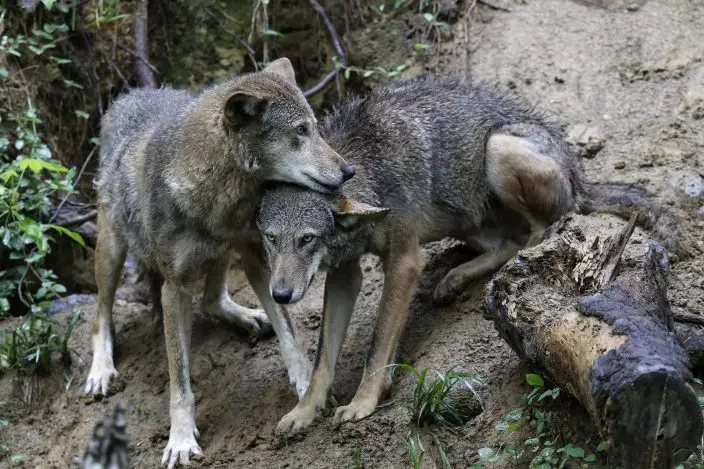
A pair of red wolves huddle at the Museum of Life and Science in Durham, N.C., on Monday, May 13, 2019. With less than three dozen roaming the forests of North Carolina, the red wolf has seen its numbers crash in recent years, putting it in the most precarious position of any wolf species in the U.S. (AP PhotoGerry Broome)
Wolf recovery is further hindered by political opposition over attacks on livestock or game animals and longstanding arguments over whether the wolves should be treated as distinct species warranting continued protection.
With no changes to current management, the wild population of red wolves likely will be lost within the next decade, according to federal officials . The Mexican gray wolf recovery team is more confident and hopes to double the number in the wild over several years.
FRAUGHT HISTORY, MIXED RESULTS
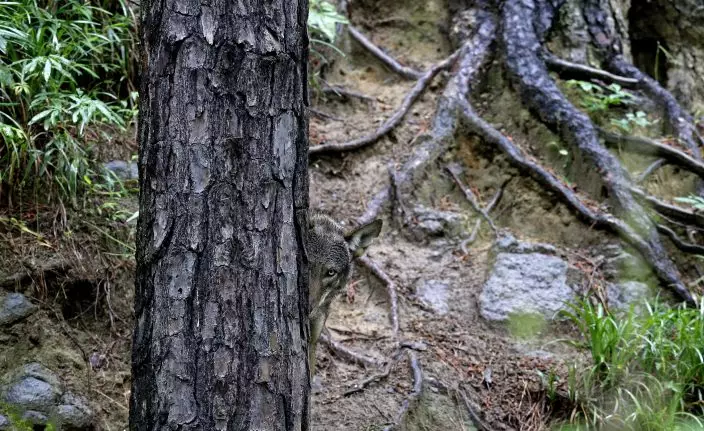
A red wolf peers from behind a tree at the Museum of Life and Science in Durham, N.C., on Monday, May 13, 2019. For red wolves, gunshot deaths are a problem particularly when hunting season collides with wolf breeding season, said Pete Benjamin, a Fish and Wildlife Service field supervisor in North Carolina. (AP PhotoGerry Broome)
Conflicts over wolves have persisted since Europeans arrived in America. Bounties paid by early settlers gave way to government extermination campaigns as the animals clashed with the agrarian way of life.
When federal officials began recovery efforts in the late 1960s, only remnant populations remained — Western gray wolves along the U.S.-Canada border, red wolves on the Gulf Coast of Texas and Louisiana and Mexican wolves south of the border.
Reintroduction programs faced stiff resistance from ranchers and rural communities, a hurdle that so far the Western gray wolf alone has overcome.
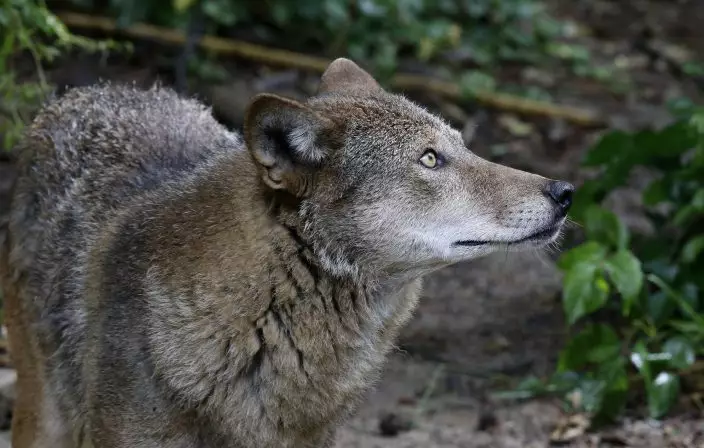
A red wolf roams its habitat at the Museum of Life and Science in Durham, N.C., on Monday, May 13, 2019. Wolf recovery is hindered by political opposition over attacks on livestock or game animals and longstanding arguments over whether the wolves should be treated as distinct species warranting continued protection. (AP PhotoGerry Broome)
Western gray wolves now number around 6,000 in the Northern Rockies, Pacific Northwest and Western Great Lakes. They're legal to hunt in Montana, Idaho and Wyoming, and U.S. officials in March announced plans to end their remaining federal protections across the Lower 48 states.
The main reason for their success is location: Western gray wolves were reintroduced to areas with expansive public lands and plenty of deer, elk and other prey.
"The habitat was so good that it didn't matter if half the people hated them," said Ed Bangs, a retired federal biologist who led recovery efforts in the Northern Rockies.
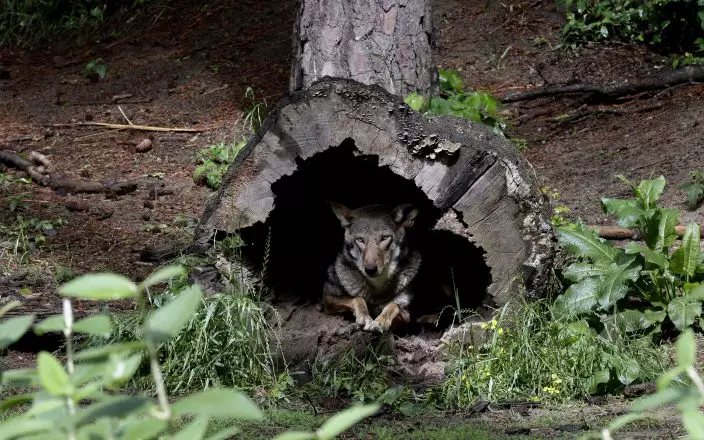
A female red wolf peers from within a tree trunk in its habitat at the Museum of Life and Science in Durham, N.C., on Monday, May 13, 2019. Conflicts over wolves have persisted since Europeans arrived in America. Bounties paid by early settlers gave way to government extermination campaigns as the animals clashed with the agrarian way of life. (AP PhotoGerry Broome)
By contrast, Mexican wolves live in isolated desert mountain ranges, where year-round livestock grazing increases their odds of running into trouble. Red wolves are in an area dominated by farms and private land.
At least 96 red wolves died of gunshot wounds over nearly three decades. For Mexican wolves, 83 deaths were classified as "illegal" over 20 years and that doesn't include any of the 21 deaths in 2018 still under investigation.
The Mexican and red wolf populations are struggling despite a great amount of money and work put into their reintroduction.
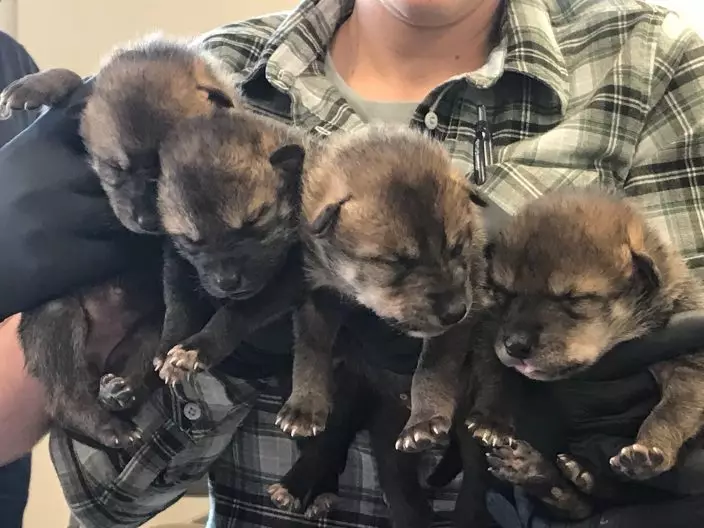
FILE - In this April 18, 2019 photo provided by the Endangered Wolf Center in Eureka, Mo., four of six Mexican wolves born recently in captivity are held at the center, after landing in Phoenix, Ariz., for relocation into the wild. A team from the center and U.S. Fish and Wildlife biologists placed them with wolf dens along the Arizona and New Mexico borders, where they will be raised by foster parents in the wild. Officials with the center say the pups add to the population in the wild but also add much-needed genetic diversity. (Endangered Wolf Center Rachel Crosby via AP)
Since 1977, more than $44.2 million has been spent on the Mexican wolf, according to federal reports. At least $39.4 million has been spent on red wolves over the past three decades.
About $160 million more has been spent primarily on Western gray wolves.
DWINDLING RED WOLVES
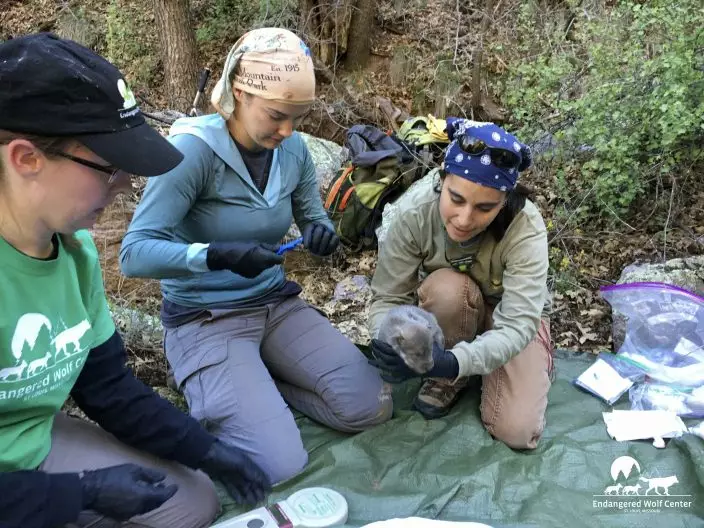
FILE - In this April 18, 2019 photo provided by the Endangered Wolf Center in Eureka, Mo., Regina Mossotti, left, U.S. Fish and Wildlife biologists Cyrenea Piper, center, and Allison Greenleaf prepare Mexican wolf pups born in captivity at the center to be relocated to wolf dens along the border of Arizona and New Mexico. Six pups at the center were placed with dens in the wild in an effort to increase population and add genetic diversity. The Mexican wolf, which once numbered in the hundreds of thousands, was nearly extinct before repopulation efforts began in the 1970s. About 150 now live in the wild in the Southwest. (Rachel CrosbyEndangered Wolf Center via AP)
Legal protections for red wolves have been solidified by the recent scientific conclusion that they're a distinct species, not a wolf-coyote hybrid as some landowners argued. But conservationists worry the news comes too late, with only 25 to 30 of the canines left in the wild and 200 or more in captive breeding programs.
After red wolves were reintroduced to North Carolina in 1987, the wild population grew beyond 100 and remained stable through 2012.
"For almost 25 years, this was hugely successful. It was money well-spent," said Ramona McGee, a lawyer for the Southern Environmental Law Center.
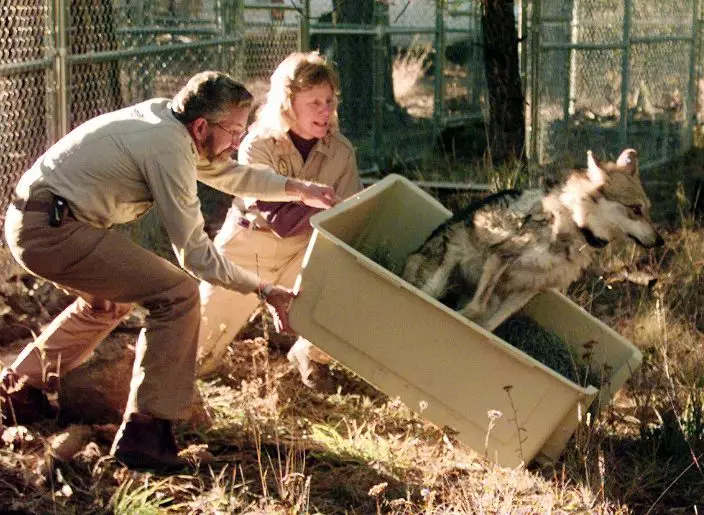
FILE - In this Monday, Nov. 16, 1998 file photo, David Parsons, leader of the Mexican wolf recovery team of the U.S. Fish and Wildlife service and Diane Boyd-Heger, a Mexican wolf biologist, lift a crate carrying a female Mexican wolf who refused to leave her cage after being released into the wild, in the Apache National forest in Alpine, Ariz. (AP PhotoJeff Robbins, File)
Yet a 1990 federal recovery plan goal for 220 animals in the wild was never met.
Wolf numbers were bolstered by releases of captive-born pups and sterilization of coyotes that competed for space. But those approaches were halted in 2015 amid pressure from conservative politicians and landowners who deemed wolves a nuisance.
Conservationists contend the government abandoned proven techniques. "The biggest problem now is not the mortality, it's the lack of releases," said McGee, the lawyer.
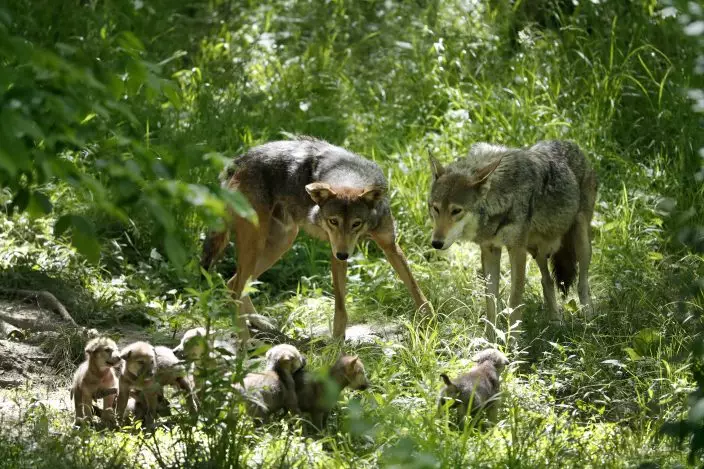
American red wolves Artemis, right, and Oka, left, keep watch over their 5-week-old pups at the Endangered Wolf Center in Eureka, Mo., on Monday, May 20, 2019. For red wolves, gunshot deaths are a problem particularly when hunting season collides with wolf breeding season, said Pete Benjamin, a Fish and Wildlife Service field supervisor in North Carolina. (AP PhotoJeff Roberson)
Benjamin, the government field supervisor, said the wild red wolf population already was declining before pup releases stopped, declining to say whether political pressure influenced the decision.
Bill Rich, an eastern North Carolina landowner, complains wolves have made it harder to fight coyotes that kill deer on game land. A federal judge in 2014 banned night hunting of coyotes in red wolf territory because the canines are easily mixed up.
Rich says the reintroduction program is a failure and should be scrapped.
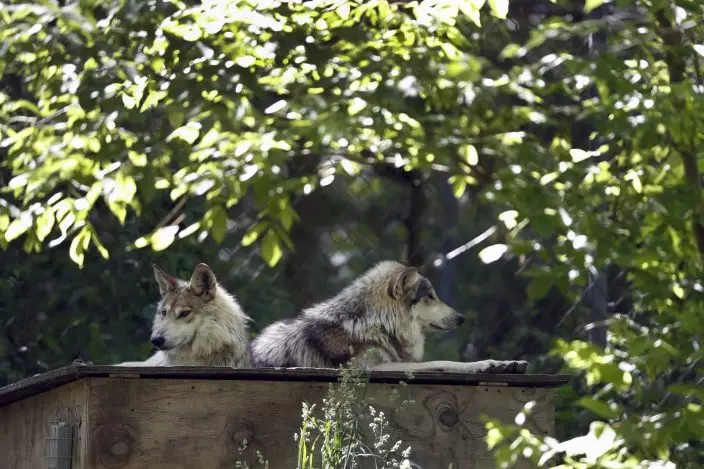
Mexican gray wolves rest atop their den at the Endangered Wolf Center in Eureka, Mo., on Monday, May 20, 2019. With such small numbers in the wild, biologists say poaching has a big effect. Over the last two decades, more than half of Mexican wolf deaths and about one in four red wolf deaths resulted from gunshots or were otherwise deemed illegal, The Associated Press found. (AP PhotoJeff Roberson)
HURDLES IN THE SOUTHWEST
Federal managers face similar resistance in the Southwest, where ranchers see Mexican wolves as a threat to their livelihood. Wolves were found responsible for killing nearly 100 cows and calves last year. In March alone, livestock kills totaled 20, and ranchers say their calving rates are dropping because of the wolves.
Wolves also represent competition to outfitters and hunters seeking elk in southwestern New Mexico and Arizona.
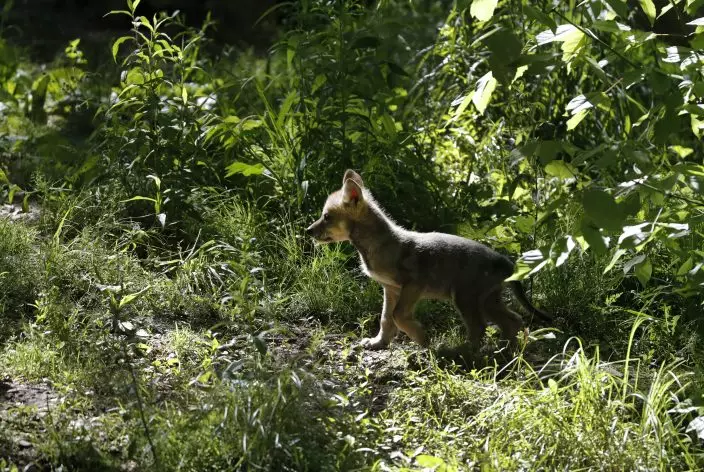
A 7-week-old Mexican gray wolf pup explores its surroundings at the Endangered Wolf Center Monday, May 20, 2019, in Eureka, Mo. The Mexican gray wolf recovery team hopes to double the number in the wild over several years. (AP PhotoJeff Roberson)
Tom Klumker, a hunting guide in the Gila backcountry, fears the reintroduction program will push ranchers, hunters and rural residents from the land.
"We were doing pretty well with just the mountain lion and bear and coyotes but when they added the wolves to the mix, why, things started to go south pretty quick," he said.
Environmentalists have long criticized the Fish and Wildlife Service for not releasing more captive-bred Mexican wolves. They're suing over the federal recovery goal of 320 wolves in the wild, saying it should be vastly more than that.
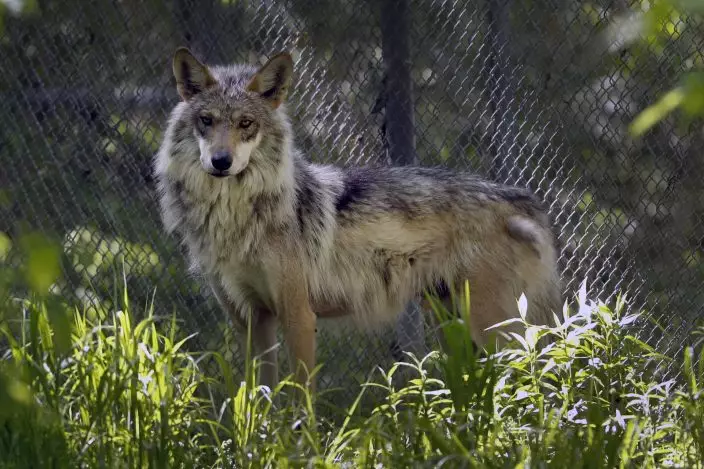
A Mexican gray wolf is seen at the Endangered Wolf Center Monday, May 20, 2019, in Eureka, Mo. Federal managers face resistance in the Southwest, where ranchers see Mexican wolves as a threat to their livelihood. Wolves were found responsible for killing nearly 100 cows and calves last year. (AP PhotoJeff Roberson)
Retired biologist Dave Parsons, who led Mexican wolf recovery efforts during the 1990s, said the government has a responsibility under the Endangered Species Act to ensure the predators have a chance to fulfill their ecological role.
Otherwise, he said, the wolves risk becoming "museum pieces in the wild."
Follow Matthew Brown at https://twitter.com/matthewbrownap , Jonathan Drew at www.twitter.com/JonathanLDrew and Susan Montoya Bryan at https://twitter.com/susanmbryanNM

This May 25, 2014 photo provided by the Oregon Department of Fish and Wildlife shows a 100-pound adult male wolf which was outfitted with a GPS radio-collar in the Mt. Emily area. The Mexican and red wolf populations are struggling despite a great amount of money and work put into their reintroduction. (ODFW via AP)
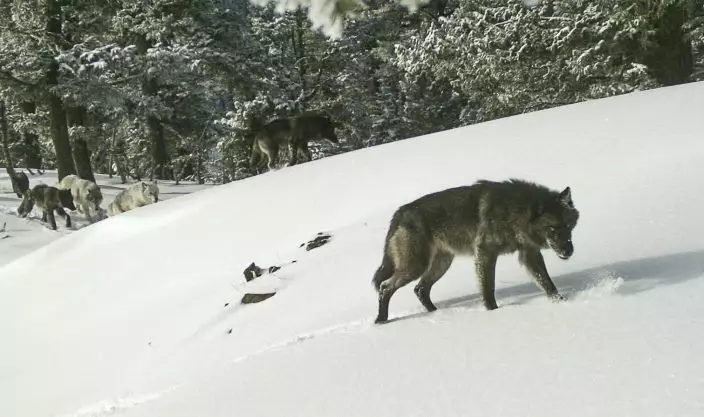
This Feb. 1, 2017 photo provided by the Oregon Department of Fish and Wildlife shows the Western gray wolf Snake River pack seen by a remote camera in the Hells Canyon National Recreation Area. (ODFW via AP)
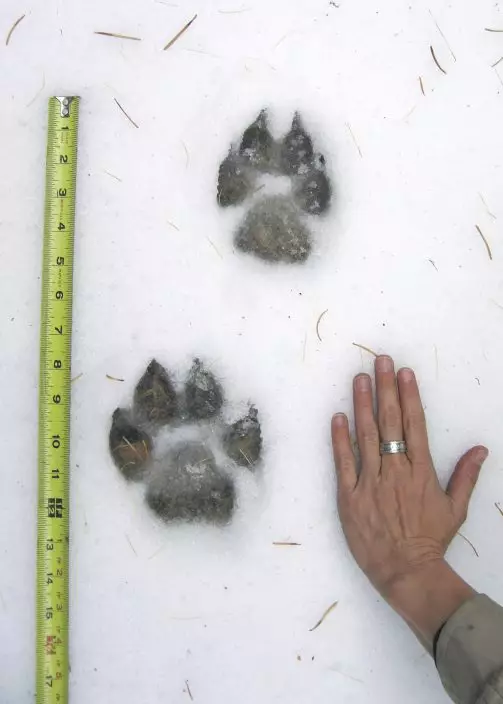
This Fall 2007 photo provided by the Oregon Department of Fish and Wildlife shows Western gray wolf tracks in the north Keating Wildlife Management Unit in Baker County. A wolf's hind foot is smaller in size and generally placed in front of the front foot when trotting. (ODFW via AP)
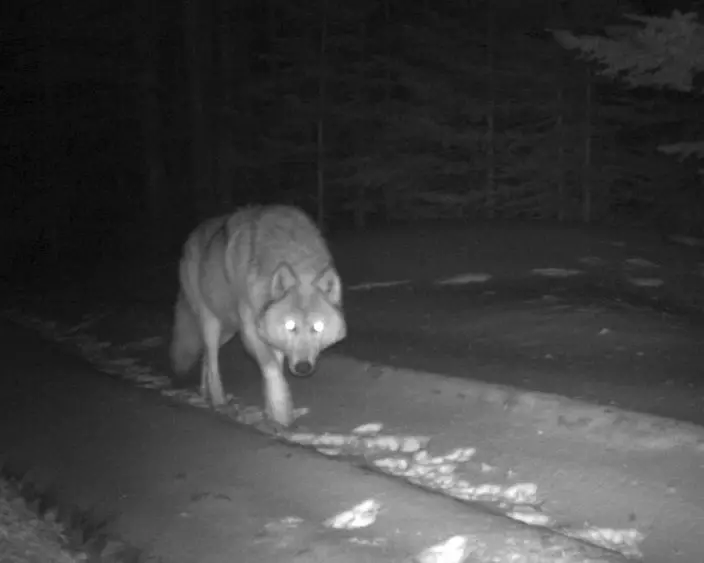
This Jan. 21, 2017 photo provided by the Oregon Department of Fish and Wildlife shows a Western gray wolf from the Walla Walla Pack seen by a remote camera in northern Umatilla County. (ODFW via AP)
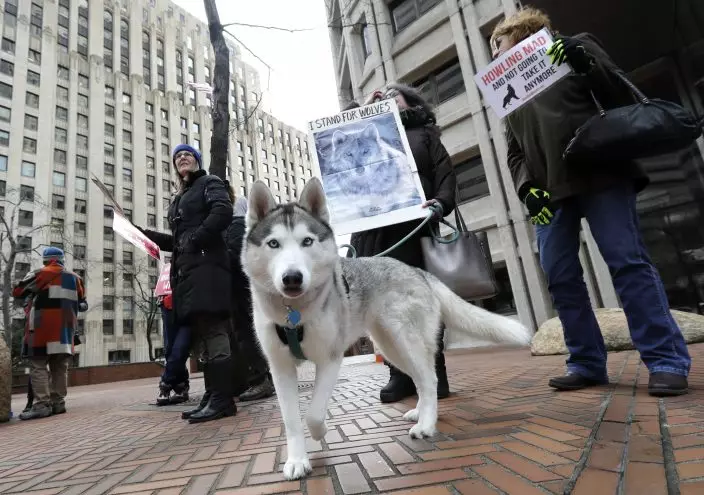
FILE - In this Thursday, March 7, 2019 file photo, Ella, a Siberian Husky, stands with her owner, Tracey Conway, second from right, during a protest at the Henry M. Jackson Federal Building in Seattle. Protesters were opposing a proposal made Wednesday by the Trump administration to lift protections for gray wolves across the Lower 48 states. The plan has gotten a mixed reaction in Washington state. (AP PhotoTed S. Warren)
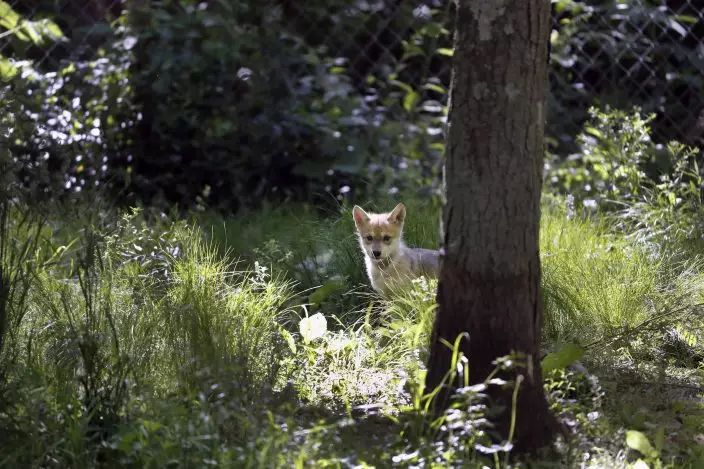
A 7-week-old Mexican gray wolf pup explores its surroundings at the Endangered Wolf Center in Eureka, Mo., on Monday, May 20, 2019. Retired biologist Dave Parsons, who led Mexican wolf recovery efforts during the 1990s, said the government has a responsibility under the Endangered Species Act to ensure the predators have a chance to fulfill their ecological role. Otherwise, he said, the wolves risk becoming “museum pieces in the wild.” (AP PhotoJeff Roberson)
PARIS (AP) —
Reuters photographer Mohammed Salem captured this year’s prestigious World Press Photo of the Year award Thursday with a depiction of loss and sorrow in Gaza, a heartrending photo of a Palestinian woman cradling the body of her young niece. The photograph, taken in Khan Younis just days after Salem’s own child was born, shows 36-year-old Inas Abu Maamar holding five-year-old Saly, who was killed along with her mother and sister when an Israeli missile struck their home.
Salem, who is Palestinian, described this photo filed Nov. 2 last year, as a “powerful and sad moment that sums up the broader sense of what was happening in the Gaza Strip.”
The image ”truly encapsulates this sense of impact,” said global jury chair Fiona Shields, The Guardian newspaper's head of photography. “It is incredibly moving to view and at the same time an argument for peace, which is extremely powerful when peace can sometimes feel like an unlikely fantasy,” she added.
The World Press Photo jury praised the shot’s sense of care and respect and its offering of a “metaphorical and literal glimpse into unimaginable loss.”
This is not the first time Salem has been recognized for his work on the Israeli-Palestinian conflict; he received a World Press Photo award more than a decade ago for another depiction of the human toll of conflict in the Gaza strip.
In the three other global categories announced Thursday, South Africa’s Lee-Ann Olwage won Photo Story of the Year for her touching series “Valim-babena,” featured in GEO magazine. The project focused on the stigmatization of dementia in Madagascar, a topic she explored through intimate portraits of “Dada Paul” and his family. Lack of public awareness surrounding dementia means that people displaying symptoms of memory loss are often stigmatized.
In the series, “Dada Paul,” who has lived with dementia for 11 years, is tenderly cared for by his daughter Fara. One of the standout images in the series shows him preparing for church with his granddaughter Odliatemix, capturing moments of normalcy and warmth amidst the challenges of dementia.
Photographer Alejandro Cegarra, a Venezuelan native who migrated to Mexico in 2017, won the Long-Term Project award for “The Two Walls,” published by The New York Times and Bloomberg. Cegarra’s project, initiated in 2018, examines a shift in Mexico’s immigration policies, which have moved from being historically open to enforcing strict regulations at its southern border. The jury said the photographer's perspective as a migrant gave it a “sensitive," human-centered perspective, according to a press release.
Julia Kochetova of Ukraine won the Open Format award for “War Is Personal.” The project stood out from coverage of the ongoing conflict by offering a personal look at the harsh realities of war. On a dedicated website, she merged traditional photojournalism with a diary-like documentary style, incorporating photography, poetry, audio clips and music.
The Associated Press won the Open Format award in the regional Africa category with the multimedia story “Adrift,” created by journalists Renata Brito and Felipe Dana. The story investigates the fate of West African migrants who attempted to reach Europe via a treacherous Atlantic route but ended up on a ghost ship discovered off Tobago. The team’s compelling use of photography, cinematography and detailed narrative, enhanced by expert design and multimedia elements, highlights the perils faced by migrants and the human stories behind global migration issues.
The Associated Press' Ebrahim Noroozi won the Asia Stories award for his series “Afghanistan on the Edge,” which documents the country since the Taliban took over in August 2021.
World Press Photo is an independent, nonprofit organization based in the Netherlands, founded in 1955.

This image provided by World Press Photo is part of a series titled Afghanistan on the Edge by Ebrahim Noroozi, Associated Press, which won the World Press Photo Asia Series category and showsAn Afghan refugee rests in the desert next to a camp near the Torkham Pakistan-Afghanistan border, in Torkham, Afghanistan, Friday, Nov. 17, 2023. A huge number of Afghans refugees entered the Torkham border to return home hours before the expiration of a Pakistani government deadline for those who are in the country illegally to leave or face deportation. (AP Photo/Ebrahim Noroozi)
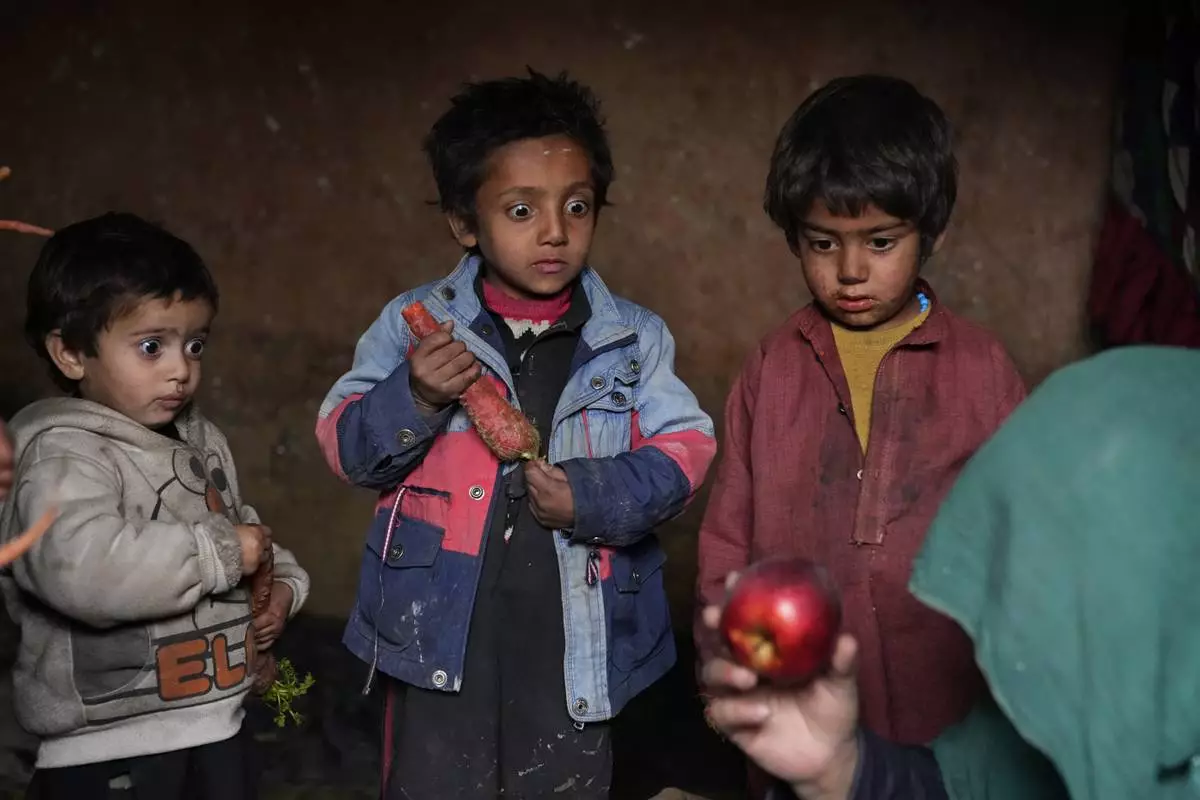
This image provided by World Press Photo is part of a series titled Afghanistan on the Edge by Ebrahim Noroozi, Associated Press, which won the World Press Photo Asia Series category and shows : Since the chaotic Taliban takeover of Kabul on Aug. 15, 2021, an already war-devastated economy once kept alive by international donations alone is now on the verge of collapse. There isn't enough money for hospitals. The World Health Organization is warning of millions of children suffering malnutrition, and the U.N. says 97% of Afghans will soon be living below the poverty line. Three Afghan internally displaced children look with surprise at an apple that their mother brought home after begging, in a camp on the outskirts of Kabul, Afghanistan, Thursday, Feb 2, 2023. (AP Photo/Ebrahim Noroozi)

This image provided by World Press Photo is part of a multimedia project by Associated Press' Renata Brito and Felipe Dana titled Adrift, won the World Press Photo Africa Regional Winner Open Format category and shows a mortuary technician opening the door of a refrigerator used to store the remains of migrants recovered from inside the Mauritania boat that appeared drifting near the island of Tobago, in Scarborough, Trinidad and Tobago, Tuesday, Jan. 25, 2022. In May 2021 a boat from Mauritania full of dead men was found off the coast of the Caribbean Island of Tobago. Who were these men and why were they on the other side of the Atlantic Ocean? Two visual journalists sought answers, uncovering a story about migrants from West Africa who seek opportunity in Europe via an increasingly popular but treacherous Atlantic route. (AP Photo/Felipe Dana)
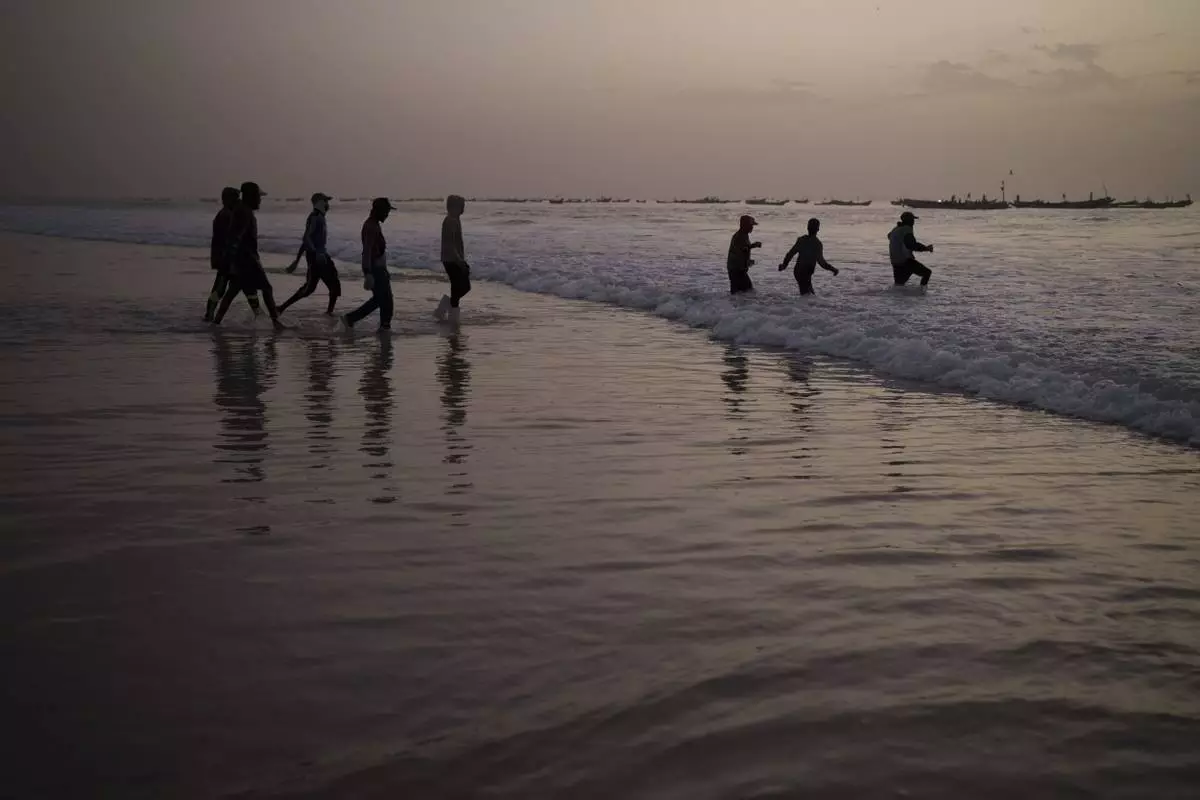
This image provided by World Press Photo is part of a multimedia project by Associated Press' Renata Brito and Felipe Dana titled Adrift, won the World Press Photo Africa Regional Winner Open Format category and shows young fishermen walk into the ocean to board an artisanal fishing boat in Nouakchott, Mauritania, Friday, Dec. 10, 2021. In May 2021 a boat from Mauritania full of dead men was found off the coast of the Caribbean Island of Tobago. Who were these men and why were they on the other side of the Atlantic Ocean? Two visual journalists sought answers, uncovering a story about migrants from West Africa who seek opportunity in Europe via an increasingly popular but treacherous Atlantic route. (AP Photo/Felipe Dana)

This image provided by World Press Photo is part of a multimedia project by Associated Press' Renata Brito and Felipe Dana titled Adrift, won the World Press Photo Africa Regional Winner Open Format category and shows Moussa Sako, an asylum-seeker from Mali, who survived 22 days aboard a Mauritanian boat drifting in the Atlantic Ocean covers his face during an interview with the Associated Press in Guadalajara, Spain, Sunday, Nov. 14, 2021. In May 2021 a boat from Mauritania full of dead men was found off the coast of the Caribbean Island of Tobago. Who were these men and why were they on the other side of the Atlantic Ocean? Two visual journalists sought answers, uncovering a story about migrants from West Africa who seek opportunity in Europe via an increasingly popular but treacherous Atlantic route. (AP Photo/Felipe Dana)

This image provided by World Press Photo and taken by Julia Kochetova is part of a series titled War is Personal which won the World Press Photo Open Format Award. Amidst tens of thousands of civilian and military casualties and an effective stalemate that has lasted for months, there are no signs of peace on the horizon for Russia's war in Ukraine. While news media updates its audience with statistics and maps, and international attention drifts elsewhere, the photographer has created a personal website that brings together photojournalism with the personal documentary style of a diary to show the world what it is like to live with war as an everyday reality. (Julia Kochetova/World Press Photo via AP)
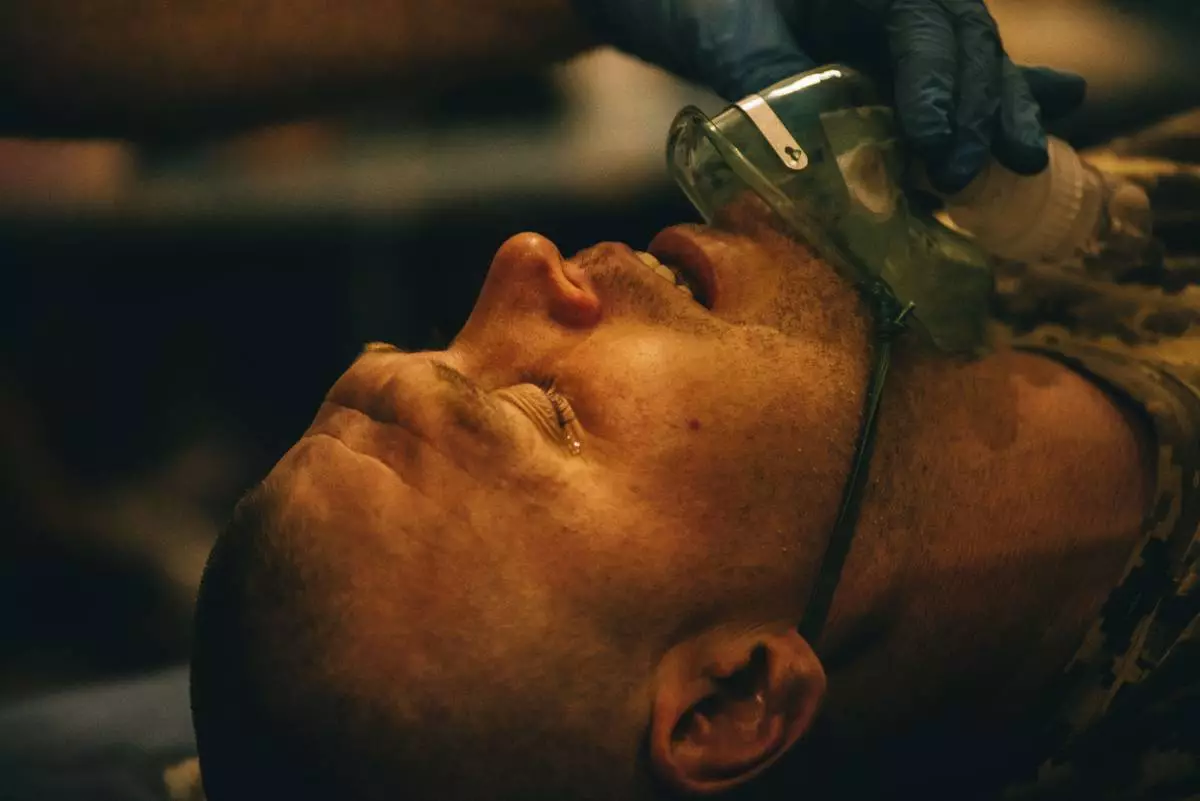
This image provided by World Press Photo and taken by Julia Kochetova is part of a series titled War is Personal which won the World Press Photo Open Format Award and shows a stabilization point near Bakhmut, Ukraine, of the 5th assault brigade and 77th brigade. Hospitalliers battalion - volunteer battalion of combat medics are helping here. Amidst tens of thousands of civilian and military casualties and an effective stalemate that has lasted for months, there are no signs of peace on the horizon for Russia's war in Ukraine. While news media updates its audience with statistics and maps, and international attention drifts elsewhere, the photographer has created a personal website that brings together photojournalism with the personal documentary style of a diary to show the world what it is like to live with war as an everyday reality. (Julia Kochetova/Der Spiegel/World Press Photo via AP)
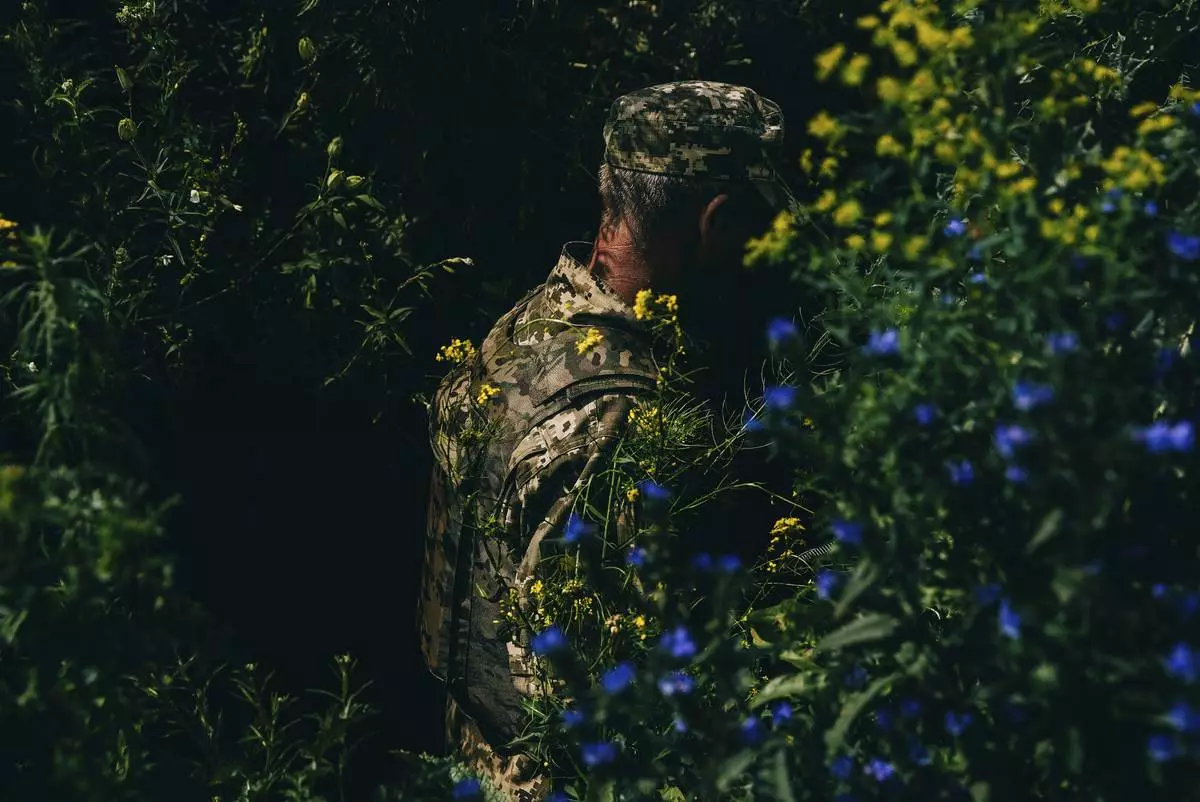
This image provided by World Press Photo and taken by Julia Kochetova is part of a series titled War is Personal which won the World Press Photo Open Format Award and shows the training of mobilized conscripts of 68th brigade in Donetsk region, not far from frontline. 68th brigade recently liberated Blagodatne village during the Ukrainian counter-offensive. The instructors came from US, working for NGO "Saber".Amidst tens of thousands of civilian and military casualties and an effective stalemate that has lasted for months, there are no signs of peace on the horizon for Russia's war in Ukraine. While news media updates its audience with statistics and maps, and international attention drifts elsewhere, the photographer has created a personal website that brings together photojournalism with the personal documentary style of a diary to show the world what it is like to live with war as an everyday reality. (Julia Kochetova/Der Spiegel/World Press Photo via AP)
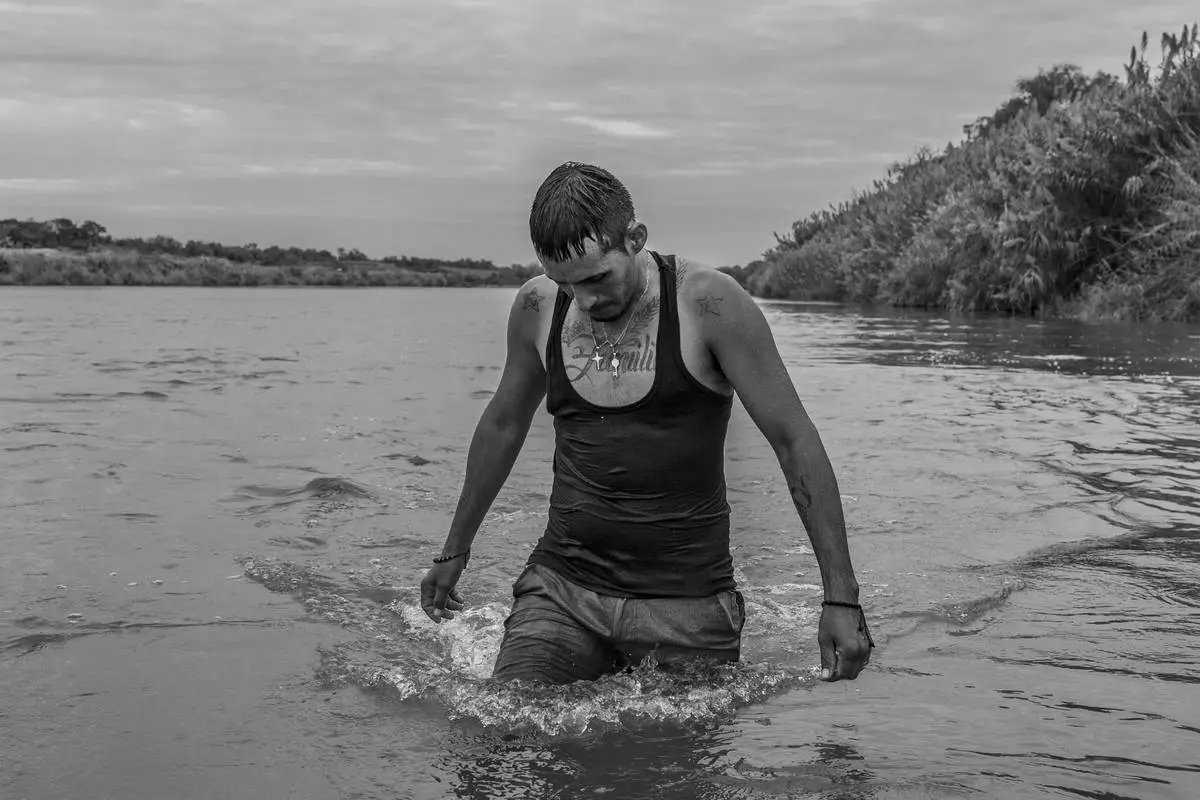
This image provided by World Press Photo and taken by Alejandro Cegarra for The New Times/Bloomberg is part of a series titled The Two Walls which won the World Press Photo Long-Term Project Award and shows Carlos Mendoza, a Venezuelan migrant, crossing the Rio Grande river to seek asylum in the United States. Piedras Negras, Mexico, 7 October 2023. (Alejandro Cegarra/The New York Times/Bloomberg/World Press Photo via AP)

This image provided by World Press Photo and taken by Alejandro Cegarra for The New Times/Bloomberg is part of a series titled The Two Walls which won the World Press Photo Long-Term Project Award and shows a migrant walking atop a freight train known as "The Beast." Migrants and asylum seekers lacking the financial resources to pay a smuggler often resort to using cargo trains to reach the United States border. This mode of transportation is very dangerous; over the years, hundreds have fallen onto the tracks and have been killed or maimed. Piedras Negras, Mexico, 8 October 2023. (Alejandro Cegarra/The New York Times/Bloomberg/World Press Photo via AP)

This image provided by World Press Photo and taken by Lee-Ann Olwage for GEO is part of a series titled Valim-babena which won the World Press Photo Story of the Year Award and shows Dada Paul Rakotazandriny (91), who is living with dementia, and his granddaughter, Odliatemix Rafaraniriana (5), get ready for church on Sunday morning at his home in Antananarivo, Madagascar. 12 March 2023. (Lee-Ann Olwage/Geo/World Press Photo via AP)

This image provided by World Press Photo and taken by Lee-Ann Olwage for GEO is part of a series titled Valim-babena which won the World Press Photo Story of the Year Award and shows Joeline (Fara) Rafaraniriana (41) watches her father, Dada Paul Rakotazandriny (91) clean fish at home on Sunday afternoon. A typical Sunday consists of the family attending church in the morning and spending time together in the afternoon. Fara works during the week and as the sole provider and carer for her daughter and father struggles to manage all her responsibilities in the absence of assistance by her siblings who live close by. Mandrosoa Ivato, Antananarivo, Madagascar. 12 March 2023. (Lee-Ann Olwage/Geo/World Press Photo via AP)

This image provided by World Press Photo and taken by Mohammed Salem of the Reuters news agency won the World Press Photo Award of the Year and shows Palestinian woman Inas Abu Maamar, 36, embracing the body of her 5-year-old niece Saly, who was killed in an Israeli strike, at Nasser hospital in Khan Younis in the southern Gaza Strip, October 17, 2023. (Mohammed Salem/Reuters/World Press Photo via AP)








































